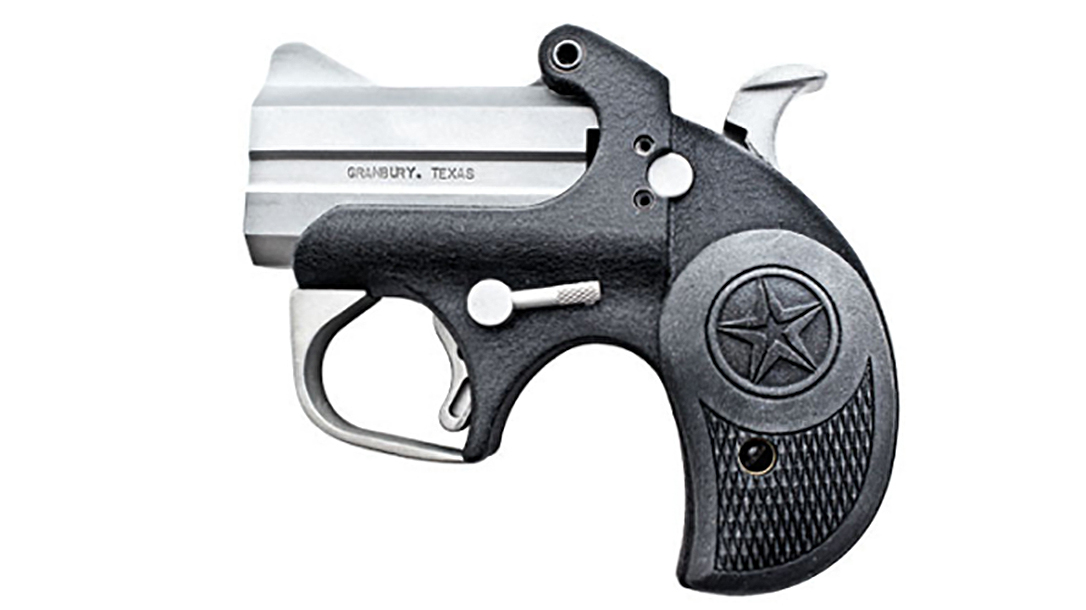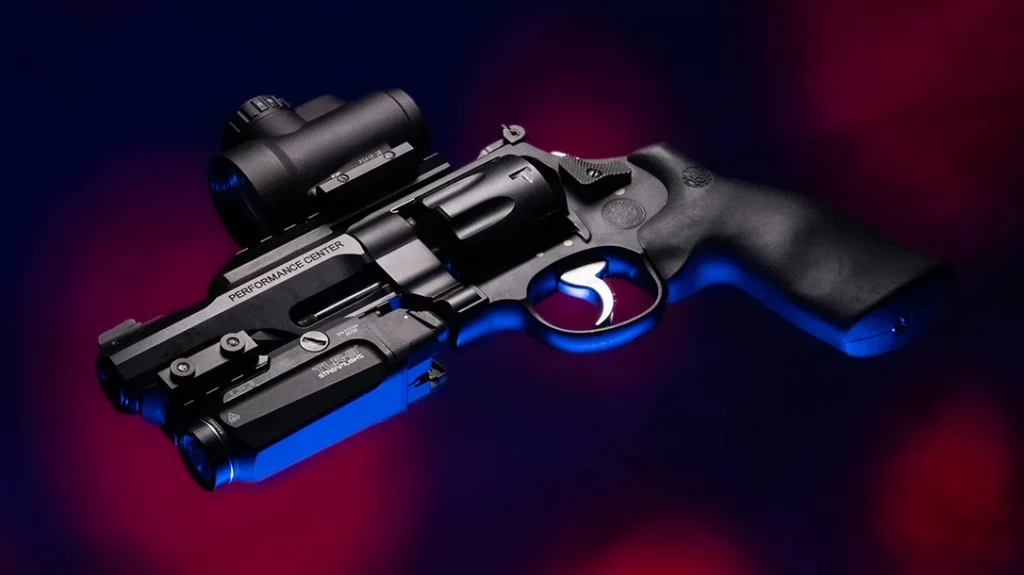Bond Arms of Granbury, Texas, is a well-known and respected manufacturer of modern derringers. With the Remington 95 derringer as a starting point, Bond Arms updated the basic design using modern materials and machining. Barrels and frames for the company’s stable use nothing but high-quality stainless steel. Bond Arms also added modern safety features. There are rebounding hammers, rebounding firing pins, push-button cross-bolt safeties, and a locking mechanism for the barrel-opening lever during fire.
Bond Arms’ derringer models provide offerings with or without triggerguards. They come in a number of barrel lengths (2.5 to 4.25 inches) and in more chamberings than most of us could imagine. Grips can be polymer, buffalo horn, rubber or different wood models.
I recently tried out one of the newer Bond offerings, the Bond Arms Backup, for myself. The sights on the compact handgun consist of a fixed-blade front sight and a rear notch in the barrel’s integral hinge wing. Bond Arms’ slightly tacky, bird’s-head design rubber grips, which provide a two-finger hold, rode the frame.
Advertisement — Continue Reading Below
My Backup had two barrel pairs chambered in .45 ACP and 9mm, and lacked the shell ejectors used with rimmed cartridges. The notched chamber opening is a square cut into the barrel’s left side that encompasses about 0.31 inches of both chambers. Fingernails are able to slip through the notch and pry the empty cases out.
RELATED: 12 Best Undercover Pocket Pistols
It was immediately obvious the Backup differed some from other Bond Arms pistols. Gone is the highly polished stainless steel barrel and frame. These have been replaced by a bead-blasted, matte-finished, 2.5-inch, stainless barrel and a black crinkle-powder-coated frame. 2.5-inch .40 barrels are also available. Both changes were made to enhance the Backup’s concealability. The hammer, trigger, triggerguard, cross-bolt safety, and lock lever were all bead blasted. This makes for an attractive contrast to the black crinkle-powder-coated frame. A polished rectangle on the frame contains the serial number.
Range Report
Shooting almost any handgun or rifle is fun to me. Because of prior experience with Bond Arms’ wares, I had an idea of what to expect with this diminutive pistol spitting 9mm and .45 ACP bullets. I couldn’t see the benefit of .45 ACP +P in the Backup, adding recoil for what I felt would be little benefit. Also it seems Bond Arms discourages .45 ACP +P ammunition.
Advertisement — Continue Reading Below
With that in mind, I took nothing but standard-pressure loads with me to wring out the Bond Arms Backup. These two loads used lighter bullets to reduce recoil in the 19-ounce pistol. I tossed in a third load of 230-grain jacketed hollow points (JHP) because I wanted to see if the recoil increased.
The 9mm loads were kept to standard-pressure configurations. For the same reasons, although Bond Arms approves its 9mm barrels for +P ammo. Recoil was slightly less than the .45 ACP, allowing for a quicker recovery.
Accuracy was more than adequate, with five-shot averages falling into groups between 2.63 and 3.99 inches for both calibers. I used only the upper barrel in the accuracy and velocity testing, to reduce variables.
Advertisement — Continue Reading Below
Targets were set at varying distances out to 7 yards. The Backup (in either caliber) and I were capable of keeping all shots in the IDPA target’s center. Empty cases slipped from the chambers with scarcely more than a fingernail touch, but reloads took quite a bit of time. Recoil was no surprise.
Reducing the barrel length and changing the Bond Arms Backup’s exterior were excellent decisions. The less-reflective finish is a nice touch and really dresses up the pistol. Bobbing the barrels lets the Backup fit into more shallow pockets.
Ammo Selection
The three sets of barrels were also tested for velocity. Given the short 2.5-inch length of all three barrels, I selected loads with light bullets for their respective calibers. That’s because I selected loads that would generate sufficient velocity and energy to give them a reasonable chance of expanding when they reached the target. A 230-grain .45 ACP JHP travelling at somewhere around 700 feet per second (fps) isn’t likely to perform well. Lighter bullets also kick less, and in an 18-ounce gun with a small grip, recoil is a definite consideration. I had a good supply of light bullet loads from Black Hills, CorBon, ICC and Liberty Ammunition on hand for testing, so I took them to the range to see how they’d do. As I thought, they generally produced relatively high velocities from the 2.5-inch barrels.
Advertisement — Continue Reading Below
I thought it might because the 9mm operates at relatively high pressures and its chamber is much shorter compared to cartridges like the .357 Magnum. Given the short 2.5-inch test barrels, a shorter chamber leaves a longer section of barrel for the expanding powder gasses to accelerate the bullet down the bore.
RELATED STORY: Ultra-Concealable Derringers From Bond Arms
This proved to be correct when comparing the 9mm to the .357 Magnum loads. Both cartridges use a 50-grain, nickel-plated, copper “cluster bullet,” which is a projectile designed to fragment into a pre-determined number of pieces. The 9mm load produced an average of 1,825 fps while the .357 Magnum produced only 1,506 fps. This compares to the company’s published test velocities of 2,000 fps for the 9mm and 2,100 fps for the .357 Magnum. Clearly, the 9mm was more efficient than the Magnum in the short derringer barrel in terms of both velocity and energy.
On the other hand, CorBon’s 160-grain, standard-pressure DPX load produced an average of 931 fps in the derringer versus its factory test velocity of 1,050 fps. It lost only 119 fps in the short derringer barrel, while the 9mm Liberty load lost 175 fps. The Liberty load was more efficient. It produced 91 percent of its test barrel velocity from the 2.5-inch barrels of the Backup, while the .45 produced slightly less at 88 percent. The 9mm also produced 369 foot-pounds of muzzle energy compared to the .45-caliber DPX’s 307 foot-pounds.
Advertisement — Continue Reading Below
Pocket Threat-Stopper
All things considered, the Backup is just what the original two-shot derringer was designed to be, and a bit more. Even when chambered for smokeless-powder revolver cartridges, it produces higher velocities and energy levels than the .41 rimfire ammo that was chambered in Remington’s original double-barrel derringer. Semi-auto cartridges do even better. In addition, the Backup is also much less prone to breakage and accidental discharge.
Does the Bond Arms Backup qualify as a backup pistol? It’s reliable, chambered for .45 ACP or 9mm, accurate (for its class) and surprisingly easy into action. It’s also small enough to fit just about anywhere, and a good assortment of leather is available to holster it. So, yes, I believe the Backup qualifies as a backup pistol quite well!
























